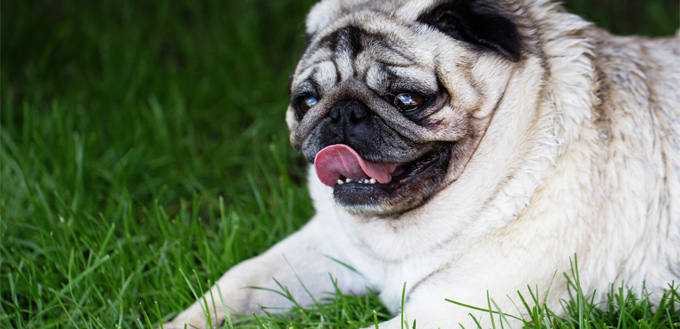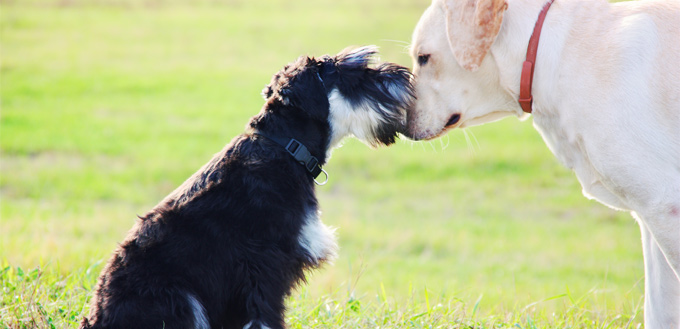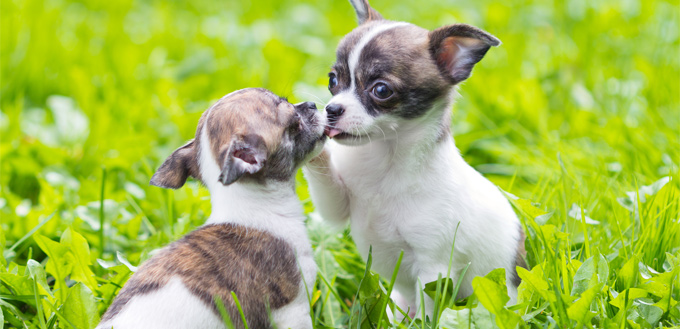When families and individuals look into buying a new dog, they are often asked whether they will be breeding their dog and whether they prefer a male or female. And yet, while periods are a part of all of our lives, we still seem to suppress the fact that dogs do indeed menstruate. It only becomes more prevalent in our mind once we notice our dog acting strangely.
Of course, dogs and human are very different in how they project these hormonal changes. Here, we look in more detail at how a bitch in heat may behave, the signs of a female dog in heat and the best ways to handle a dog in heat.
So, Do Dogs Have Periods?
When we think of periods and menstruation, our mind thinks up the classic form of human periods. Lots of blood, lots of mood swings and not much fun. Of course, dogs are physically very different from us and that means their cycle is vastly different from ours, too. So, to say that a dog has a period would not be entirely accurate.

To put things into context a little, it is best to understand that dogs follow some of the same processes as humans. In that an egg will be released and, if fertilised will then settle in the uterus and become the female’s offspring (to put it in rather blunt terms). However, the steps leading up to this point and after are vastly different.
In humans, a period will signify the end of the cycle- in that an egg was released, unfertilised and the uterus sheds the unnecessary lining to begin afresh the start of a new menstruation cycle. In dogs, the period actually signifies the beginning of the cycle. This is because dogs actually have what’s called an estrous cycle. This can last up to 180 days- just a little longer than the average 28 days of the human comparison! Within this cycle are five different phases, which we will talk about below.
How Long Does a Dog in Heat Bleed?
With quite a lot of dogs, you may not notice any bleeding at all. In fact, it could be the behavior of the female dog in heat that actually signifies their changes to you, as opposed to any blood spots. However, dogs entering the estrous cycle will begin bleeding during the proestrus phase. This is the first phase of the cycle, and is when most people would refer to the dog being “in heat”.
This phase can last between as little as one, and as many as twenty-seven days. At this point, the estrogen levels are at their peak and you’ll probably find that a lot of male dogs suddenly have a heightened interest in your bitch!
Next, your dog will enter what is known as the estrus phase. Again, this can either be a very short period of around 4 days, right up to a longer stretch of twenty-four days. It all depends on your dog, the environment, and your dog’s natural cycle, though the average length of the estrus phase is around nine days. During this time you may still notice bleeding, but the frequency and amount will be considerably less.
During the other two phases, there should be no bleeding though your dog may continue acting a little strange. For more in-depth descriptions of your female dog in heat’s behavior, keep reading.
Some Dog Menstruation Symptoms
Again, to fully clarify what is happening to your dog during their estrous cycle, it’s best to understand what hormonal changes are going on behind-the-scenes during each phase. As discussed above, there are four phases, including the two we’ve already mentioned. Each of these phases plays host to a new set of characteristics that are specific to each part of your dog’s cycle.
Symptoms that typically occur during the proestrus cycle are directly related to the high levels of estrogen that hit their highest point during this phase. At this point your dog is considered as being in heat and, physically, your dog will undergo some natural changes. This includes their vulva swelling and becoming more noticeable. Meanwhile, your dog will begin to bleed due to the blood released from the vagina and you may notice that they will be urinating a lot more frequently. This helps to spread the pheromone scent around the area. Essentially, it’s a big, fat sign to all the dogs in the area that your dog is becoming ready to mate. As such, you’ll spot male dogs becoming particularly interested in your female dog in heat. Usually, this isn’t reciprocated at this stage!

The second phase of the estrous cycle is called the estrus phase. The vulva remains enlarged and male dogs will continue to show a fascination with your dog in heat. Progesterone levels begin to increase at this point, so it’s likely that your canine companion will begin to reciprocate this intention from a willing male! Your bitch will also likely still be bleeding- though this is lighter during this phase. Finally, you may observe your dog sleeping more, or have a fascination with trying to build a “nest”, in anticipation of pregnancy. Of course, if you have no interest in breeding your female dog, now is the time to keep the males away!
When the bloody discharge stops appearing, your dog will be entering the diestrus phase- this will happen regardless of whether your dog’s egg has been fertilised during the estrus phase. This part lasts around two months, with progesterone levels peaking at around the one-month mark. If their egg has not been fertilized, then the nutrients that would otherwise be used to nurture the foetus are reabsorbed into their body and the fourth and final phase begins.
During the fourth phase, your female dog will most likely not be sexually active and hormones will return to their “dormant” state- in that they will have no effect on your dog’s sexuality. This phase lasts around three to four months and, once this ends, the cycle begins anew.
What Should I do About my Dog’s Period?
The first thing to do is not to panic if you spot some blood. Understandably, it can be a little alarming to think your dog may have been hurt or in pain but this a natural part of female dogs who are not spayed/neutered. Of course, in regard to the blood itself, the easiest way to ensure your dog doesn’t leave spots of blood around is to invest in dog period diapers. This may sound a little odd but just think of a nappy with a hole for the tail!
How to Calm a Dog in Heat
It is completely understandable that you and your dog may be a little distressed when your female dog is in heat. The key, as always, is to remain calm. Dogs are very sensitive to our emotions and stressors and will pick up on your anxiety (if you have any!). There are a few methods that may or may not work depending on your dog. Some may prefer longer walks to burn off any extra energy they may have, while others require less exercise and simply wish to sleep more. Likewise, you may find that your dog would like extra attention– or that your usually-friendly dog decides to enjoy their own company for a while.
You can also try out a few “new age” tricks. That is non-medical solutions- including using essential oils to help provide a sense of calm in the house, a dog-calming aid that’s marketed for hyperactive or anxious dogs, or even a weighted coat. The latter are used quite common throughout the world to help provide a gentle pressure to specific points, in the same way, us humans use acupressure massages to relax.
Take a look at our review of anxiety supplements for dogs.
When do Puppies Start Going into Heat?
As always, the exact timing for when your puppy will first come into heat is not written in stone. Depending on the size, breed and the environment of your female dog. For some puppies, the first cycle can be as early as six months while others may find their dogs going into the heat around the two-year mark. It is vitally important that you do not breed your dog during their first cycle. This is because they are very likely to not be fully matured and ready to give birth to their offspring.
Likewise, many vets recommend allowing your bitch to pass their first estrous cycle before having your female dog spayed. This is discussed in more detail, below.

When in Heat, Is my Dog in Pain?
Unfortunately, we are not yet able to read the minds of our canine companions. That said, it is generally agreed upon that, for some dogs at least, the pain felt by our female dogs when in heat is not dissimilar to the pain us humans feel. Essentially, the cramping and general distress caused by our muscles seizing up and generally being sent a little loopy by hormones may be present in our dogs, too. While we cannot be certain about this, we can be sure that a little love and understanding can go a long way in making your dog in heat feel a little better about herself.
What’s the Likelihood of a Dog Becoming Pregnant, in Heat
As with all things, there are a number of factors to consider here, so we cannot give you a straight answer! That said, if both sire and bitch are happy, healthy dogs, available at the right time- and willing to cooperate- the likelihood of conception is based at around fifty percent.
Spaying or Neutering Your Pet
As mentioned earlier, a lot of vets advise waiting for at least one cycle before spaying your female dog. This allows your female dog’s hormones to run their natural course and thus ensure the healthiest possible outcome of spaying your dog. Of course, in terms of having your dogs spayed or neutered later or earlier than this, there are pros and cons to each argument. The general recommended period given by most vets is to have your dog spayed or neutered around the six-month area.
Note: The advice provided in this post is intended for informational purposes and does not constitute medical advice regarding pets. For an accurate diagnosis of your pet's condition, please make an appointment with your vet.







